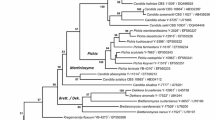Abstract
Two strains representing a single novel yeast species were isolated from a flower of Calycoopteris floribunda Lame (SK170T) and insect frass (ST-122) collected in Thailand. On the basis of morphological, biochemical, physiological and chemotaxonomic characteristics, and the sequence analysis of the D1/D2 domain of the large subunit rRNA gene and the internal transcribed spacer region, the two strains were assigned as a single novel Candida species in the Hyphopichia clade for which the name Candida wangnamkhiaoensis sp. nov. is proposed. The type strain is SK170T=BCC 39604T=NBRC 106724T=CBS 11695T).


Similar content being viewed by others
References
Altschul SF, Madden TL, Schäffer JZ, Zhang J, Zhang Z, Miller W, Lipman DJ (1997) Gapped BLAST and PSI-BLAST: a new generation of protein database search programs. Nucleic Acids Res 25:3389–3402
Felsenstein J (1985) Confidence limits on phylogenies: an approach using the bootstrap. Evolution 39:783–791
Groenewald M, Smith MT (2010) Re-examination of strains formerly assigned to Hyphopichia burtonii, the phylogeny of the genus Hyphopichia, and the description of Hyphopichia pseudoburtonii sp. nov. Int J Syst Evol Microbiol 60:2675–2680
Kimura M (1980) A simple method for estimating evolutionary rate of base substitutions through comparative studies of nucleotide sequences. J Mol Evol 16:111–120
Kuraishi H, Katayama-Fujimura Y, Sugiyama J, Yokoyama T (1985) Ubiquinone systems in fungi. I. Distribution of ubiquinones in the major families of ascomycetes, basidiomycetes, and deuteromycetes, and their taxonomic implications. Trans Mycol Soc Jpn 26:383–395
Kurtzman CP (1998) Pichia E.C. Hasen emend. Kurtzman. In: Kurtzman CP, Fell JW (eds) The yeasts, a taxonomic study, 4th edn. The Netherlands, Elsevier, pp 273–352
Kurtzman CP (2005) New species and a new combination in the Hyphopichia and Yarrowia yeast clades. Antonie van Leewenhoek 88:121–130
Kurtzman CP (2011) Hyphopichia von Arx & van der Walt. In: Kurtzman CP, Fell JW, Boekhout T (eds) The yeasts, a taxonomic study, 5th edn, vol 2. Elsevier, Amsterdam, pp 435–438
Limtong S, Yongmanitchai W, Tun MM, Kawasaki H, Seki T (2007) Kazachstania siamensis sp. nov., an ascomycetous yeast species from forest soil in Thailand. Int J Syst Evol Microbiol 57:419–422
Nagatsuka Y, Kawasaki H, Mikata K, Seki T (2005) Candida khmerensis sp. nov., a novel cation-tolerant yeast isolated from dry salted shrimp and sewage in Cambodia. J Gen Appl Microbiol 51:235–243
Nakase T, Suzuki M (1986) Bullera megalospora, a new species of yeast forming larger ballistospores isolated from dead leaves of Oryza sativa, Miscanthus sinesis and Sasa sp. in Japan. J Gen Appl Microbiol 32:225–240
Saitou N, Nei M (1987) The neighbor-joining method: a new method for reconstructing phylogenetic trees. Mol Biol Evol 4:406–425
Tamura K, Dudley J, Nei M, Kumar S (2007) MEGA4: molecular evolutionary genetics (MEGA) Soft-ware version 4.0. Mol Biol Evol 24:1596–1599
Thompson JD, Gibson TJ, Plewniak F, Jeanmougin F, Higgins DG (1997) CLUSTAL_X windows interface: flexible strategies for multiple sequence alignment aided by quality analysis tools. Nucleic Acids Res 24:4876–4882
von Arx JA, van der Walt JP (1976) The ascigerous state of Candida chodatii. Antonie van Leewenhoek 42:309–314
White TJ, Bruns T, Lee S, Taylor JW (1990) Amplification and direct sequencing of fungal ribosomal RNA genes for phylogenetics. In: Innis MA, Gelfand DH, Sninsky JJ, White TJ (eds) PCR protocols: a guide to methods and applications. Academic Press, New York, pp 315–322
Yamada Y, Kondo K (1973) Coenzyme Q system in the classification of the yeast genera Rhodotorula and Cryptococcus, and the yeast-like genera Sporobolomyces and Rhodosporidium. J Gen Appl Microbiol 19:59–77
Yarrow D (1998) Methods for the isolation, maintenance and identification of yeasts. In: Kurtzman CP, Fell JW (eds) The yeasts, a taxonomic study, 4th edn. Elsevier, Amsterdam, pp 77–100
Acknowledgment
This study was partial supported by the Higher Education Research Promotion and National Research University Project of Thailand, Office of the Higher Education Commission.
Author information
Authors and Affiliations
Corresponding author
Rights and permissions
About this article
Cite this article
Limtong, S., Kaewwichian, R., Jindamorakot, S. et al. Candida wangnamkhiaoensis sp. nov., an anamorphic yeast species in the Hyphopichia clade isolated in Thailand. Antonie van Leeuwenhoek 102, 23–28 (2012). https://doi.org/10.1007/s10482-012-9709-z
Received:
Accepted:
Published:
Issue Date:
DOI: https://doi.org/10.1007/s10482-012-9709-z




